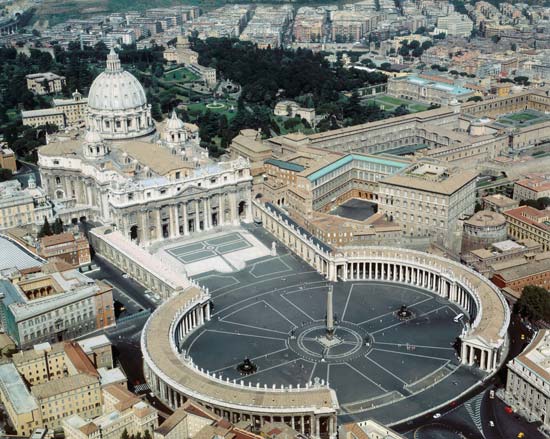Baroque architecture
Contents |
[edit] Introduction
Baroque architecture is a style that emerged in Italy in the late-16th century.
It was a more theatrical version of Renaissance architecture, with dramatic lighting and colour, illusory effects such as trompe l’oeil, and designs that played games with architectural features, sometimes leaving them incomplete.
Its buildings typically include central towers, domes, portico or other central projections in the main façade. As Baroque architecture coincided with European colonialism, it can be seen throughout much of the world; and in some regions, notably Germany and colonial South America, it lasted until the 18th century.
[edit] History
Baroque developed in the Counter-Reformation period, when the Catholic Church needed to reassert its waning influence across Europe in the face of the Protestant Reformation. One way of attracting new followers was to create overtly emotional and sensory displays in art and architecture. Church architecture appealed as much to the emotions as to the intellect of the faithful, attempting to persuade them into unconditional loyalty to the church. Approaching and entering a church became a symbolic, sensorial and mysterious experience.
While initially finding form in church and cathedral design, the style was later used as a visual demonstration of absolutist regimes in the form of elaborate royal palaces.
The late Baroque style is often referred to as Rococo or, in Spain and Spanish America, as Churrigueresque.
[edit] Style and characteristics
Baroque architecture is characterised by dynamic designs and complex architectural plan forms; intended to heighten feelings of motion and sensuality, and frequently based on the oval. There is often a mixture of the repetition, break-up and distortion of Renaissance classical motifs.
- Grandeur.
- Contrast.
- Curves and twists.
- Rich surface treatments.
- Gilded statuary.
- Bright colours.
- Vividly painted ceilings.
- Fragmented or deliberately incomplete elements.
- Large-scale frescoes.
- Dramatic central projections on an external façade.
- Use of plaster or stucco, marble or faux finishing.
- Illusory effects such as trompe l’oeil.
- Pear-shaped domes (more common in Eastern Europe baroque).
[edit] Notable buildings
The most notable practitioners of the baroque style in Italy included Gian Lorenzo Bernini, Carlo Maderno, and Francesco Borromini. Developing later, in central Europe the most notable architect was Johann Bernhard Fischer von Erlach. In Britain, baroque was adopted by Christopher Wren and Nicolas Hawksmoor.
Some of the most notable buildings incorporating the baroque style are:
- St. Paul’s Cathedral, London.
- Winter Palace, St. Petersburg.
- Karlskirche, Vienna.
- Palace of Versailles, Versailles.
- Les Invalides, Paris.
- St. Peter’s Square, Vatican City.
- San Carlo alle Quattro Fontane, Rome.
- St. John’s Co-Cathedral, Valletta, Malta.
[edit] Related articles on Designing Buildings
- Architectural styles.
- Art Deco.
- Bauhaus.
- Beaux Arts style.
- Belvedere.
- Classical architecture
- Eclecticism.
- Fountaine Hospital Almshouse.
- International Style.
- Italian Renaissance Revival style.
- Modernist architecture.
- Monopteros.
- Neoclassical architecture.
- Palladian architecture.
- Piazza.
- Postmodern architecture.
- Restoring Orleans House Octagon.
- Rococo.
- Scagliola.
- Stuart architecture.
- Trompe l’oeil.
- Zeitgeist.
Featured articles and news
Government consultations for the summer of 2025
A year of Labour, past and present consultations on the environment, the built environment, training and tax.
CMA competitiveness probe of major housing developers
100 million affordable housing contributions committed with further consultation published.
Homes England supports Greencore Homes
42 new build affordable sustainable homes in Oxfordshire.
Zero carbon social housing: unlocking brownfield potential
Seven ZEDpod strategies for brownfield housing success.
CIOB report; a blueprint for SDGs and the built environment
Pairing the Sustainable Development Goals with projects.
Types, tests, standards and fires relating to external cladding
Brief descriptions with an extensive list of fires for review.
Latest Build UK Building Safety Regime explainer published
Key elements in one short, now updated document.
UKGBC launch the UK Climate Resilience Roadmap
First guidance of its kind on direct climate impacts for the built environment and how it can adapt.
CLC Health, Safety and Wellbeing Strategy 2025
Launched by the Minister for Industry to look at fatalities on site, improving mental health and other issues.
One of the most impressive Victorian architects. Book review.
Common Assessment Standard now with building safety
New CAS update now includes mandatory building safety questions.
RTPI leader to become new CIOB Chief Executive Officer
Dr Victoria Hills MRTPI, FICE to take over after Caroline Gumble’s departure.
Social and affordable housing, a long term plan for delivery
The “Delivering a Decade of Renewal for Social and Affordable Housing” strategy sets out future path.
A change to adoptive architecture
Effects of global weather warming on architectural detailing, material choice and human interaction.
The proposed publicly owned and backed subsidiary of Homes England, to facilitate new homes.
How big is the problem and what can we do to mitigate the effects?
Overheating guidance and tools for building designers
A number of cool guides to help with the heat.
The UK's Modern Industrial Strategy: A 10 year plan
Previous consultation criticism, current key elements and general support with some persisting reservations.
Building Safety Regulator reforms
New roles, new staff and a new fast track service pave the way for a single construction regulator.

























